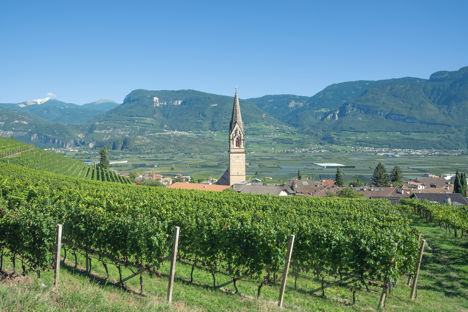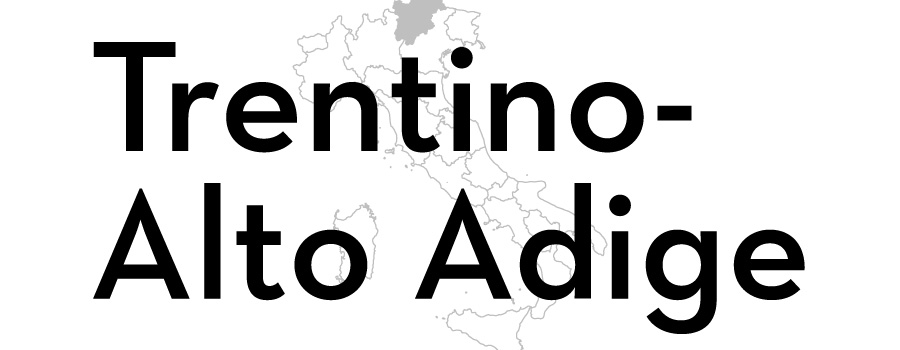
The wines of South Tyrol
Marco Rossi travels to the Dolomites in the very north of Italy to discover crisp wines full of mineral flavours and fresh aromas.
View more from this series:
Italian wineWe all have a journey, made in a particular stage of our life, that we remember forever. Ten years ago I would have thought visiting somewhere like Burgundy or Champagne would be my favourite ever trip. I never thought there’d be a day when it would be South Tyrol (also known as Alto Adige), but the region’s wine stays with you long after you’ve left.
A land illuminated with mountains, lakes, rivers and green valleys that run from 200 metres above sea level up to over 3,000, South Tyrol is home to vineyards, beautiful orchards, huge happy cattle and a people who have made the most of the land, with its ancient soul and terroir.
South Tyrol is a bit of Austria, a bit of Germany and a bit of Italy all put together, but at the same time it is totally unique; a pure and unpolluted world where typical alpine elegance is reflected in every single aspect of everyday life. Wines made in the Dolomites reflect the soul of the land – they are full-bodied and mineral with a hint of freshness and intense aroma. Some call South Tyrol the Italian Alsace, but that does no justice to the farmers who started making high quality wine in this area 3,000 years ago.
The moment I got off the train at Bolzano's railway station, the majesty of the mountain peaks and the light that continuously chases the shadow of the valleys kept me company until I reached my hotel room. On my journey I was surprised by the quality of the many specialised wine bars scattered around the city, and it became obvious that South Tyrol is a region very focused on wine. It is the Italian territory with the highest number of ‘Tre Bicchieri’ accolades from the publication Gambero Rosso (the most famous Italian wine award) in relation to the size of the vineyards.
Fancy travelling to South Tyrol's wine country yourself? There are a number of hotels dotted throughout the region specialising in wines and vineyards. Visit Vinum Hotels to learn more.
Another thing that makes South Tyrol an important winemaking region is that ninety-nine percent of the wine produced in the region falls under a DOC, a percentage higher than any other Italian region. It is because of this that I’ve decided to introduce you to the wines of this area in a slightly different way than my previous articles. We will look at the seven production areas and then ‘taste’ the most important grape varieties, rather than just talk about DOCs and IGTs (there are no DOCGs in the region).
South Tyrol is a region traditionally focused on red wines but in just in a few years it has become famous for its whites too. The traditional grape varieties are more than enough to make us salivate – Schiava gives life to simple and elegant red wines which are very drinkable and not very tannic; Lagrein imparts power and pride to a wine and Gewurz, which comes from the charming town of Tramin, is beloved for its flavour. Now, I am not a great lover of aromatic grapes, especially when they are grown all around the world, but the results achieved with Gewurz are definitely worth trying. And we cannot forget the mysterious pink Moscato Rosa of Sicilian origin that is wisely safeguarded by one of the oldest wine farms in Europe, the Abbazia di Novacella.
The seven winemaking areas of South Tyrol
(Pinot Grigio, Chardonnay, Schiava, Gewurztraminer and Pinot Noir)
The area that gave birth to Gewurz grapes, this is the largest wine region of South Tyrol and is also the area with the warmest climate thanks to the constant gentle winds coming from the south. Mountagna and Mazzon represent two very famous sites for wine but it is the town of Tramin and its Gewurz grapes that are truly unmatched.
(Schiava, Pinot Blanc, Chardonnay, Sauvignon, Gewurztraminer)
This is a sub-region quite famous for its castles and noble estates that arise around Appiano and Caldaro. The vineyards here run from 300 to 700 metres above sea level and they are well known for producing crisp white wines, but next to Appiano we found an incredible estate with a beautiful wine resort called Stroblhof. Working mainly with Pinot Noir, in just a few years it has reached the highest levels of winemaking.
(Schiava, Lagrein, Gewurztraminer, Pinot Blanc)
This area lies in a very sunny valley with planting altitudes that reach more than 900 metres above sea level. Close to the capital are expressions of both old and modern grape varieties, Schiava and Lagrein, which are very popular internationally.
(Sauvignon, Pinot Blanc, Schiava, Lagrein)
Characterized by dry land, vineyards with very deep roots and a very ancient wine culture, here you can find three of the most important and famous communes known for making wines with minerality: Terlano, Adriano and Nals.
(Schiava, Pinot Noir, Pinot Blanc)
Historically a town famous from a touristic point of view, Merano was also able to establish itself for its wines, produced in sandy soils less than 800 metres above sea level. The DOC Alto Adige Merano is focused on the Schiava grape and its almost undetectable tannins, but the area has become even more famous for the incredible results achieved with Merlot and Pinot Noir.
(Muller Thurgau, Sylvaner, Kerner, Gewurztraminer)
This area is the most northern wine region of Italy and also one of the oldest. It is home to the famous winery Abbazia di Novacella, which has been making wine expertly since 1142. The local soils create powerful and structured wines with a rare but extremely refined minerality and freshness.
(Riesling, Pinot Blanc, Pinot Nero, Schiava)
This area is famous for its apple orchards and an extremely dry alpine climate. From its sandy soils, the wines take on very unique and elegant characteristics.
• Evidence of vines being cultivated in 500 BC
• 1142 Abbazia di Novacella begins making wine
• 1814 South Tyrol is annexed to Austria
• ‘Wines of Bolzano’, a very important wine expo, opens it doors in 1896
• South Tyrol Steps into the Kingdom of Italy in 1918 right at the end of the first World War
• The DOC Alto Adige comes to life in 1975
• The Alto Adige Wine Consortium is born in 2007
The seven wine varieties of South Tyrol
Visual: vibrant yellow with golden shades when older
Bouquet: intense floral aroma with distinctive notes of roses, lychees and yellow tropical fruit
Taste: quite fresh on the palate without being too persistent, finishing with a slight mineral aftertaste
Pairing: fish, Asian cuisine, lobsters, prawns, foie gras
Must try:
Traditional: Cantina Tramin – Gewurztraminer Nusbaumer Alto Adige DOC
New wave: Pacherhof – Gewurztraminer Val D'Isarco DOC
Visual: yellow with golden shades
Bouquet: peach and orange, becoming stronger when aged
Taste: really fresh on the palate with quite a long persistence, finishing with a strong mineral aftertaste and no sweetness as there is no residual sugar
Pairing: shellfish, oysters, pasta dishes and Japanese cuisine
Must try:
Traditional: Abbey of Neustift – Riesling Riserva Praepositus
New wave: Falkenstein – Riesling Val Venosta DOC
Visual: vibrant pink with ruby shades
Bouquet: very floral, with a distinctive red rose aroma. Spices and small red fruits with hints of sweetness
Taste: quite fresh on the palate and really dense and persistent, finishing with a sweet aftertaste perfectly balanced by the minerality
Pairing: desserts such as strudel, crepes, cocoa and strawberry cakes
Must try:
Traditional: Franz Haas – Moscato Rosa Alto Adige DOC
New wave: Elena Walch – Moscato Rosa Alto Adige DOC
• Alto Adige is a region north of the Adige River
• It is less than 8,000 square kilometers large and one of the lowest population densities in Italy
• The region it is bordered to the north by Switzerland and Austria, to the west with Lombardy, to the south with Trentino and to the east with Veneto
• 5,300 hectares of vines
• Vineyards go from 200 to 1,000 metres above the sea level
• 20 different grape varieties cultivated in the region
Visual: pale light ruby red with garnet shades, going slightly orange when older
Bouquet: fresh aromas of cherry, raspberry, strawberry and blueberry, with floral aromas like violet and rose. With ageing some intense spicy notes appear
Taste: fresh on the palate, really elegant and persistent with quite low tannins, finishing with a slight mineral aftertaste
Pairing: game, roasted meat, aged cheese
Must try:
Traditional: Brunnenhof – Pinot Nero Riserva Mazzon
New wave: Stroblhof – Pinot Nero Riserva Blauburgunder Alto Adige DOC
Visual: intense violet dark red with high coloring
Bouquet: evolved aromas of violet, tomato leaf, green pepper and intense spice
Taste: round and intense on the palate, really powerful and persistent, quite high tannins, finishing with a strong mineral aftertaste
Pairing: game, roasted meat, aged cheese
Must try:
New wave: Manincor – Reserve del Conte Alto Adige IGT (Merlot, Cabernet Sauvignon and Lagrein)
Visual: light ruby red
Bouquet: fresh aromas of cherry, floral aromas like delicate rose. Quite simple and not that intense
Taste: Fresh on the palate, almost no tannins, finishing with a slightly bitter almond aftertaste
Pairing: Speck, fresh cheese, veal and South Tyrol's traditional dishes
Must try:
Traditional: Cantina Produttori San Paolo – Schiava Passion
New wave: Pardellerhof – Schiava Rosé
Visual: intense violet dark red
Bouquet: aromas of red berries, fresh cherry and violet
Taste: round and intense on the palate with silky, persistent tannins, finishing with a strong mineral aftertaste
Pairing: red meat, aged cheese
Must try:
Traditional: Tenute Kornell – Lagrein Riserva Staves
New wave: Winery Bozen – Lagrein Riserva Taber



